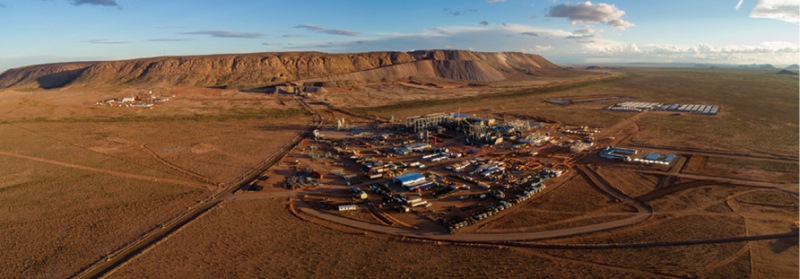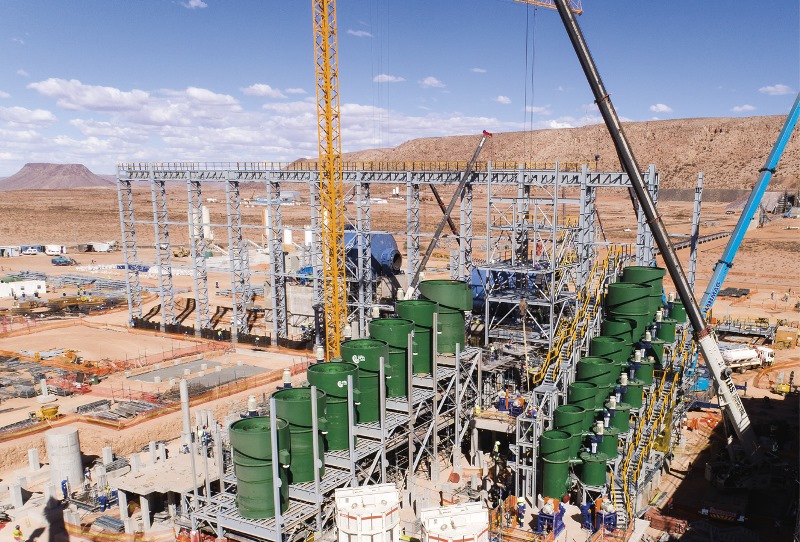Overview of the Northern Cape mining sector
When phase three is reached, the biggest new mining project in South Africa will deliver 600 000 tons of zinc for Vedanta Zinc International.
Located about 60 km from the small Northern Cape town of Pofadder, the Gamsberg zinc project (pictured above and below) has so far attracted $400-million in investment from the company and started trucking product to the Port of Saldanha in 2018. Phase one of the open-pit operation will deliver an annual load of 250 000 tons of zinc. If it proceeds to phase three, it would likely go underground.
Anil Agarwal, chairman of Vedanta Resources Limited, was quoted by the Sunday Times in 2019 saying that another $400-million might well be committed by the company as it strives to ramp up production volumes.

South African President Cyril Ramaphosa, a former mine union official, was the guest of honour when the Gamsberg project was officially opened. He made a plea for South Africa to create more value from its mineral products. He said, “We must therefore move away from the ‘pit to port approach’ where resources mined here are transported out of the country as raw as they are from along the Sishen-Saldanha route.”
Ramaphosa was referring to the 861 km railway line that carries iron ore from the northern parts of the Northern Cape Province to the Port of Saldanha on the west coast. The line has a capacity of 60-million tons-per-year but a truck colliding with a bridge in November 2018 led to the closure of the line and reduced capacity. The line was repaired in record time and services returned to normal.
The president’s wishes might well be answered by Vedanta who have expressed an interest in building a refinery and a smelter. The fact that South Africa’s power grid has been experiencing shutdowns is less of a problem when one considers that Vedanta is the world’s largest single independent power producer. In India it uses coal and renewable resources to generate 10 000 MW.
At the same time, the Northern Cape Province is continuing with planning towards developing a deep-water port at Boegoebaai. Part of the strategy involves the creation of a commodities corridor linking the Upington Special Economic Zone (SEZ) with the port. The Gamsberg Mine and related industrial investment along the corridor would increase the sustainability of the project.
President Ramaphosa made specific pledges from government’s side to fast-track development around the zinc project. He announced the establishment of an inter-governmental task team led by the Department of Trade and Industry to explore the possibility of establishing a Special Economic Zone to unlock further investment in sulphuric acid and fertiliser. The aim is to develop infrastructure, accelerate skills development and empowerment, and consolidate economic development in the Northern Cape.
The president praised Vedanta for spending R44-million on skills development, health, enterprise development and municipal infrastructure support in 2018, with a further R77.5-million spent on local businesses. Ramaphosa also noted the significance of the Gamsberg Mine being considered one of the most digitally advanced mines in South Africa.
Other news in the zinc sector is that Australian miner Orion is putting considerable resources into investigating the possible revival of the Prieska Zinc-Copper Project. A maiden mineral resource estimate was published in February 2018 and 14 drill rigs are at work looking into the site’s prospects.
Small-scale mining has been problematic in recent years. It is hoped that the recent issuing of small-scale mining permits will allow individuals access mineral resources in a way that reduces risk. The Office of the Premier, in partnership with the National Department of Mineral Resources, has held a workshop for artisanal mine workers on how to conduct legal mining operations. The Swedish International Housing Company is another partner in identifying possible land on which artisanal miners can legally start sustainable mining operations. Land owned by municipalities at Prieska, Niekerkshoop, Marydale and Griekwastad is the focus of these initiatives.
The National Youth Development Agency (NYDA), the provincial government and Mintek are collaborating on the Prieska Loxion Hub (PLH), which beneficiates tiger’s eye for jewellery and stone-cutting products.
Mining sector employment rose somewhat in 2017/18, reaching a total of 27 000.
Mining assets in the Northern Cape
- 95% of South Africa’s diamond output
- 97.6% of alluvial diamond mining
- 13.4% of world lead exports
- 80% of the world’s manganese resource
- 25% of the manganese used in the world
- 100% of South Africa’s tiger’s eye
- largest national production of sugilite (a semi-precious stone).
Rare earth elements
Rare earth elements (REE) are a very modern mineral, in that large parts of the modern economy rely on them. Super-conductors, X-ray machines, nuclear batteries and PET-scan detectors are just some of the technologies that rely on rare earth elements such as promethium, thulium and holmium. China controls 95% of the world’s supply of REEs and the search is on for alternative sources. Two sites in western South Africa have attracted investors attention: Zandkopsdrift (Northern Cape) and, close by but in the adjoining province of the Western Cape, Steenkampskraal.
Diamonds
Another change took place in the diamond ownership environment in 2018 when Ekapa Mining paid R300-million to buy out Petra Diamonds from its Kimberley Ekapa Mining Joint Venture (KEM JV). Petra held 75.9% of the old De Beers assets that include Kimberley Underground Mines, various dumps around the town and underground resources at Bultfontein, Dutoitspan and Wesselton. Ekapa’s plans to keep the mines and tailings in profit entail the use of modern technology. This includes an automated pan plant in support of an upgraded Combined Treatment Plant.
Rockwell Diamonds, which is listed on the TSX and JSE, has several assets in the Northern Cape. They lie between Prieska and Douglas, south-west of Kimberley: Wouterspan, Nieuwejaarskraal, Remhoogte and Saxendrift.
Away from the underground kimberlite pipes and fissures, river and coastal deposits are also present. Diamonds have been recovered along the Orange, Buffels, Spoeg, Horees, Doom and Swart rivers in the province, while coastal deposits have been found from the mouth of the Orange River to Lamberts Bay.
In 2018, Trans Hex sold two mines to LOR Diamonds, a black-owned company led by women, but will continue to mine the property as an independent contractor.
The Kimberley International Diamond and Jewellery Academy (KIDJA) continues to provide training with a total of 406 graduates having so far passed through the academy. In a recent development, De Beers Sightholder Sales South Africa awarded KIDJA an amount of R500 000 for bursary students. Ten diamond processing bursaries will also be supported by Alexkor for local Richtersveld communities.
Quartz
Quartz is used in the manufacture of semiconductors, fibre-optic cables and ceramics. Fused quartz improves the efficiency of solar powered devices and quartz glass is used in the manufacture of photovoltaic cells. Positive tests have been done at Riemvasmaak where the silica content is 99.98% in some places. Difeme, a black start-up, will mine the quartz with technical help from Mintek. Investors are sought for the development of a processing and beneficiation plant for high-purity quartz.
Iron ore and manganese
In 2019, Sitatunga Resources purchased the East Manganese project on the Hotazel-Kalahari ore belt from Southern Ambition. Menar Holdings, which controls a majority share in Sitatunga, is mostly invested in coal.
Afrimat, a listed construction materials supplier and industrial minerals group, has added open-pit mining to its portfolio with the R322-million acquisition of the Diro mine, which had been in business rescue. The Diro mine has proven run-of-mine reserves of 10-million tons.
The overwhelming majority of the world’s manganese comes from the Postmasburg and Kalahari regions of the Northern Cape. Assmang has two manganese mines in the province: Nchwaning and Gloria.
The Northern Cape produces more than 84% of South Africa’s iron ore. The province has two major iron belts, from Postmasburg to Hotazel, and running through Sishen and Kathu. Sishen is the most important iron-ore mine in South Africa, where operations include extraction and four beneficiation plants. The availability of natural resources, labour and infrastructure (including the Sishen-Saldanha railway line), make Sishen the ideal location.
Kumba Iron Ore has the huge Sishen facility at Kathu and Kolomela. Assmang, a joint venture comprising African Rainbow Minerals and Assore, mines at Khumani. The company will spend R2.7-billion on upgrading its Gloria mine.
South32 is very active in the Northern Cape. The Hotazel Manganese Mines are made up of two mines, Wessels (underground) and Mamatwan (open cut), and the Metalloys manganese smelter. The company has 30% of the product from its mines processed at the smelter, where a managese alloy is made.
Hotazel is also the site of a relatively new manganese mine, Tshipi é Borwa. Tshipi e Ntle Manganese Mining (Tshipi) is a joint venture between Pallinghurst Co-Investors (led by Brian Gilbertson) and a black empowerment company representing several groups called Ntsimbintle Mining.
Online resources:
- Minerals Council of South Africa: www.mineralscouncil.org.za
- Mining Qualifications Authority: www.mqa.org.za
- National Department of Mineral Resources: www.dmr.gov.za
- Northern Cape Department of Economic Development and Tourism: www.northern-cape.gov.za/dedat/



